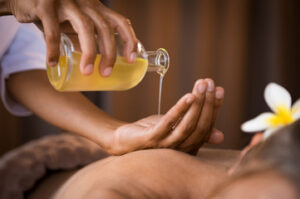Lawn care focuses on the health of turf and soil. It involves services such as mowing, fertilization, weed control and aerating.

Landscaping is a more complex process that transforms outdoor spaces. Landscapers design and install a variety of features like walkways, patios, decks, and gardens. For professional help, contact Prime Cut Lawn And Landscaping.
With consistent work and the right digital marketing strategy, you can build a strong client base for your landscaping business.
The design aspect of lawn and landscaping covers everything from deciding what plants should go where to the layout of your garden or yard. This is the artful side of gardening, where you take into consideration not just the color and shape of plant foliage but also how those plants will work with other areas in your landscape and how their form varies throughout the seasons.
Landscaping is much more than planting flowers and trees, though; it is the act of transforming outdoor spaces through construction, hardscape elements and plantation. It includes laying and installing walkways, patios, decks, stone walls and water features. It can also involve creating a backyard oasis for barbecues and parties, including the addition of outdoor lighting, a fire pit or pool.
There are a few key principles that professional landscapers use to create beautiful, functional gardens. One is unity, which means bringing all the various parts of your garden together into a coherent whole. Another is contrast, which helps to draw the eye to focal points and highlight details. For example, a straight pathway contrasting with curved beds can add a sense of harmony.
It’s also important to consider your personal style when you’re partnering with a designer. Do you like sleek modern patio furniture or do you prefer tiki bar chic for your pool party area? Be sure to share that information with your pro. They can then pull together the right mix of plants, flowers, shrubs, and trees for your yard to match your personality.
Installation
Lawn and landscaping services are different than lawn care in that they include more design-oriented work, including a variety of hardscape features. This includes decks, retaining walls, water features, walkways, patios, fire pits, and other structures that add value to properties. It also involves installing plants and trees, including privacy hedges, foundational plantings, perennial gardens, and a variety of shrubs.
When choosing a lawn and landscaping service, make sure the company has the proper licenses to operate in your area. Check with your state’s licensing authority for the exact requirements. You will also need general business liability insurance, which protects you in the event of a property damage or injury to a customer. It is a good idea to get workers’ compensation insurance as well, which protects you in the event of an accident on the job.
If you want to offer landscape installation, you need to know how to build hardscape elements like paths and driveways. This requires the use of brick, concrete, flagstone, or another material. You will also need to have a good knowledge of gardening and landscaping, including plant varieties and their needs. You may need to attend classes or workshops to learn these skills.
In addition to installation, you should also consider lawn maintenance and irrigation. Mowing is a necessary service that many homeowners and business owners need, but it can become repetitive. Lawn aeration is a specialized lawn care service that involves perforating the soil with small holes to improve air, water, and nutrient penetration into the roots of the grass. This can help the lawn grow healthier and reduce the need for weed control.
Another important lawn and landscaping service is trimming bushes and other plants around the home or business. This helps keep the property looking tidy and pulled together. This is a time-consuming task that can be difficult for many people to do on their own, so it’s often worth hiring a professional. It’s also a great way to bring in recurring revenue, as customers will need this service regularly. This is a good choice for businesses that want to keep their property pristine and attractive.
Maintenance
Whether you have a lawn or landscape that needs some attention, there are a number of ways to improve its appearance. One option is to call a professional lawn care and landscaping company. They can provide services such as cleaning up debris, mowing grass, and spring and fall clean-ups. They can also do a variety of other tasks, including mulching, edging, and trimming trees and shrubs. They can even install an irrigation system for your yard, if needed.
Lawn maintenance includes a variety of different tasks to ensure that your lawn is healthy and lush. It can include aeration services, fertilizer services, and pest control. It is important to schedule these services correctly, so that the grass can get the nutrients it needs. For example, if you water your lawn too late in the day, it may be more likely to have disease problems and to dry out.
Another type of lawn maintenance is thatching, which involves using a tool to remove the top layer of dead grass that does not grow. This prepares the lawn for new grass seed and allows it to grow easily. It is a necessary part of any lawn maintenance service.
Manhattan, NY is a densely populated urban area and home to iconic sites such as the Empire State Building, Times Square, and Central Park. It also has a great selection of restaurants, shopping, and entertainment options. This is a great place to live, work, and visit.
A great way to enhance your property’s appeal is by having a lush, green lawn. Fortunately, there are many different lawn maintenance companies that can help you achieve the perfect look. These professionals can also help you choose the best grass and plants for your space.
There are many benefits to a well-maintained lawn and landscape. It increases curb appeal, reduces stress, and lowers your energy bills. Choosing the right lawn and landscape company is crucial, but it can be challenging. Make sure to hire a company that can provide all of your lawn and landscape needs under one roof.
Pricing
The price of lawn and landscaping services vary depending on the project. For instance, installing a large addition like a pool or deck will boost your budget considerably. Additionally, the quality of your landscape will have an effect on its cost. For example, you can get away with using a cheaper ground cover rather than the more expensive pavers. It is also a good idea to buy local materials, which will be much cheaper than importing them from a different region.
Another factor that influences the price of your lawn and landscaping is the size of the area. Smaller yards will generally cost less than larger ones, because they require fewer resources to maintain. Additionally, you can save money by doing some of the work yourself. For example, mowing the grass yourself instead of hiring a professional can save you some cash.
While it is possible to do landscaping and lawn care separately, it is best if you find one company that can offer both services. This will ensure that your yard looks great and that all of your landscaping needs are met. It will also make the process easier for you, as you won’t have to deal with multiple companies.
In addition to determining the right rates for your business, you should also decide what services you are going to offer. Choosing a few core services will help you attract more customers and avoid losing them to competitors. Generally, these core services include mowing, trimming, planting flowers and trees, laying turf, fertilizing, and aerating.
The success of your lawn and landscaping business will ultimately depend on word-of-mouth marketing. It is therefore important to focus on doing a great job and building a reputation. This will allow you to gain a loyal following and build your business over time. In the long run, this will lead to a higher income for your company. If you want to maximize your profits, consider working with a digital marketing expert, as this will help you to reach more people online. You should also keep in mind that competition is fierce, and it will be essential to differentiate yourself from your competitors.








